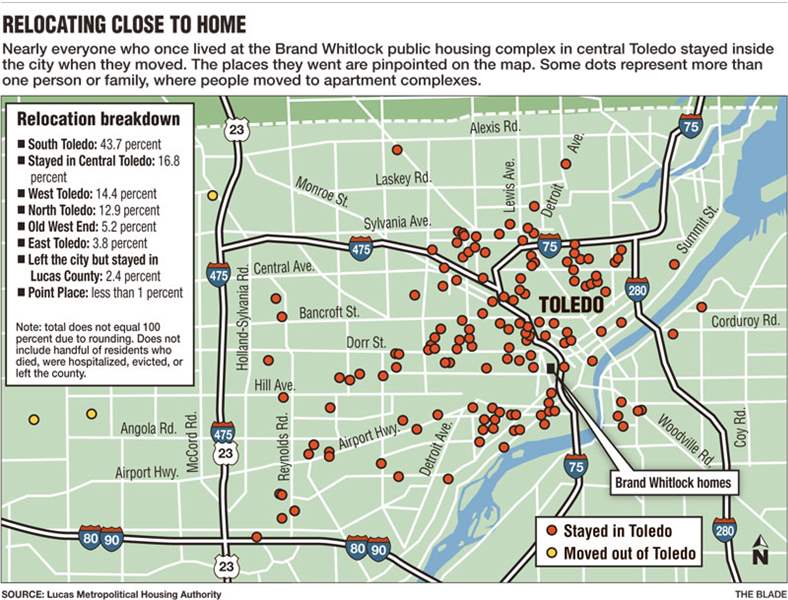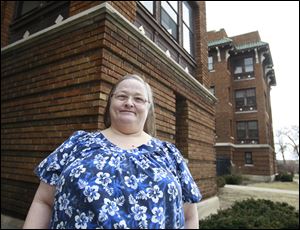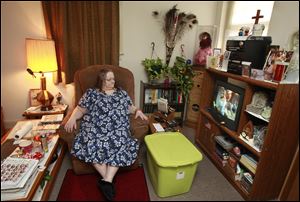
Most of Brand Whitlock's ex-residents staying in Toledo
2/27/2012

Mary Puckett didn’t go far when she left the Brand Whitlock complex, her home for the last 20 years. She’s now in the Old West End’s Museum Place apartments, mainly because she wanted to stay close to her daughter.
When it was time to leave the Brand Whitlock Homes, Tonya Duncan knew she wanted a better neighborhood -- one that she hoped would be less violent than the central city.
Ms. Duncan and her three children didn't go very far. They now live in South Toledo in the 43609 ZIP code. She wanted to remain close to her daughter's school -- she has a scholarship to Central Catholic High School -- and close to her mother, who is 65 and has health problems.
Ms. Duncan, 37, and her family are typical of many former residents of Brand Whitlock Homes.
The complex, along with the adjacent Albertus Brown Homes, is being torn down as part of a redevelopment project.
The vast majority of former residents -- about 97 percent -- still live within the city of Toledo, with very few moving to suburban addresses, a Blade analysis of data from the Lucas Metropolitan Housing Authority shows. More than 200 families relocated, leaving the Brown and Brand Whitlock Homes between May, 2011, and January of this year. Residents could either move to another site owned by LMHA or use a Housing Choice Voucher, known as a Section 8 voucher, to rent a privately owned house or apartment. Most chose a voucher.
Part of the intent of the voucher program is to try to de-concentrate poverty that some older public housing complexes historically exacerbated, but residents relocating with vouchers can face challenges if they try to leave the central city.
Only five families left the city for the Holland and Sylvania ZIP codes. A Blade analysis shows many residents -- 43.7 percent -- moved to South Toledo ZIP codes. The second largest group of residents -- 16.8 percent -- stayed in central Toledo.
About 14.4 percent headed to West Toledo and 12.9 percent to North Toledo. Smaller numbers moved to the Old West End (5.2 percent), East Toledo (3.8 percent), and Point Place (less than 1 percent).
The central Toledo Brand Whitlock Homes, bounded by Division Street, Belmont and Nebraska avenues, and I-75, will be replaced with the Collingwood Green, which will have fewer units.
Mary Puckett is another resident who didn't go far when she left Brand Whitlock, her home for the last 20 years. She's now living in the Old West End, mainly because she wanted to stay close to her daughter. She never considered moving to a suburban community, she said.
"My daughter doesn't live far from here," said Ms. Puckett, 57. "She wanted me close." Ms. Puckett does not own a car and depends on her daughter for transportation, she said.
Tierra Nelson, 27, similarly did not even consider taking her voucher and heading to a suburb with her son and daughter.
"It was too far from things I'm already used to," she said. "Right here is where I'm from." She added, "I don't want to go somewhere and have it not work out and have the neighbors not be friendly."
These three women all offered a typical reason why many Section 8 voucher-holders chose not to relocate to outlying suburbs, said Kenya Covington, an associate professor of urban studies and planning at California State University Northridge. "All their [social] networks are still within the central city," she said.
Relocation challenges

Beatrice Dillard, another resident who moved with her two children to the 43607 ZIP code in South Toledo, had another major consideration -- "I don't have transportation so I couldn't go too far," she said.
Although Ms. Puckett, Ms. Duncan, Ms. Nelson, and Ms. Dillard are all happy in their new homes, residents relocating with Section 8 vouchers can face challenges.
Section 8 is a federally funded program under which the housing authority pays a subsidy to a private landlord on the renter's behalf. The tenant pays the difference between the rent charged by the landlord and the amount subsidized by the program.
Allowing residents a chance to move to a neighborhood of their choice is supposed to offer residents greater opportunity. The number of vouchers is limited; more than 8,000 applicants are on the waiting list in Lucas County, according to a recent report to the LMHA board.
Toledo has a small portion of residents using vouchers in its suburbs compared to other metropolitan areas, said Lance Freeman, an associate professor at Columbia University.
Housing segregation
A study by Mr. Freeman showed only about 8.3 percent of voucher holders lived in the region's suburbs; Toledo ranks 98th out of the nation's 100 largest metro areas for its share of Section 8 residents in suburbs. It could be that the suburbs have fewer affordable rental units, the metro area has more segregation compared with others, or that not many suburban landlords will accept the vouchers, said Mr. Freeman.
Legally, landlords do not have to accept Section 8 tenants, explained Michael Marsh, vice president at the Fair Housing Center in Toledo. "That contributes to housing segregation," he said.
The HOME Act, a bill in Congress, would expand the Fair Housing Act to prohibit landlords from discrimination based on source of income.
When The Blade called a dozen area apartment rental listings in Holland, Swanton, Sylvania, Point Place, West Toledo, and South Toledo, two landlords said they did accept the vouchers. One said he never had, but would consider it. The remainder did not accept the vouchers. "You can see what kind of a limit that has on someone who depends on a Section 8 voucher," Mr. Marsh said.
Ms. Nelson estimates she called between 40 and 50 landlords when looking for a place to move late last year. "We kind of get stereotyped," she said of Section 8 renters. "They thought if we just got our voucher, we [were] coming from the projects."
When Ms. Dillard was looking for her new home, she said she encountered landlords who didn't understand how Section 8 worked.
"There were quite a few people who I spoke to and they didn't understand what it was," she said. "But once I explained what it was, they were interested. They thought it was people who didn't pay rent -- but I explained, it's a guaranteed rent."
When families can't move to neighborhoods with better opportunities, that harms the entire region, said Jason Reece, a senior researcher at the Kirwan Institute for the Study of Race & Ethnicity at Moritz College of Law at Ohio State University.
"What is the societal cost of denying those folks their rights and keeping them in those [low opportunity] neighborhoods? Every bit of research in the last half century shows us that those kids are going to struggle … The societal cost to that is huge." When vast numbers of children struggle in central-city neighborhoods and don't receive a good education, "a place like Toledo is not going to be able to compete. And that's not just the inner city's problem. That is the region's problem," Mr. Reece said.
Concentrating poverty

Mary Puckett says she is thrilled with her Museum Place apartment and never considered moving to a suburban community.
The Brookings Institution published a study last year naming Toledo Number One among the nation's largest metro areas for its increase in concentrated poverty. More than 46,000 people reside in neighborhoods with poverty rates of 40 percent or higher in the metro area which includes Lucas, Fulton, Ottawa, and Wood counties -- with all but one of the 22 poor neighborhoods located within the borders of Toledo.
A study last year by the director of the Kirwan Institute looked at where more than 3,400 Section 8 residents in Lucas County live and found nearly three-quarters are in "low or very low opportunity areas." Low opportunity indicators are statistics such as low graduation rates and high student-teacher ratios, according to the report, which was written for Advocates for Basic Legal Equality in litigation against LMHA.
One resident who did move to Sylvania is Verdie McIntosh, who after nine years of living "in the Brands" now has a one-bedroom apartment in a pretty, tree-lined complex off Brint Road. Ms. McIntosh said she purposely chose the suburb because she didn't want to stay in a central-city neighborhood.
"If they're going to rent to me, I can move to Sylvania just like anyone else," she said.
Ms. McIntosh, 51, said she likes her apartment, but probably will not renew her lease because taking the bus is not very convenient and she doesn't own a car.
Linnie Willis, LMHA executive director, said her agency works to educate landlords about Section 8 and recruit new landlords to the program.
"We think that it is an advantage," she said. "As a landlord, they have an opportunity to provide a comfortable and safe place for a family to live. For the landlord, it provides a guaranteed income stream."
LMHA also worked hard to assist former Brand Whitlock and Albertus Brown residents in their moves, Mrs. Willis said. The agency had three relocation specialists who helped residents with paperwork, assisted with finding units, and counseled about what neighborhoods to consider.
"There are a lot of reasons why people choose to live in certain places," she said, adding some residents wanted to remain near their church or family. "Some people just don't have a desire to live in Sylvania or Perrysburg. They want to be in the city."
Another challenge, Mr. Reece believes, is to keep affordable Section 8 housing from becoming too concentrated in certain neighborhoods or apartment complexes. One South Toledo complex has 14 Brand Whitlock and Albertus Brown families who used vouchers.
"We don't want to re-create housing projects in what were once apartment complexes," said Mr. Reece. Affordable housing on a scale that re-concentrates the poverty that the Section 8 voucher is meant to avoid is no solution, he said.
Mrs. Willis said she believes many families chose that complex because they wanted to remain close to their Brand Whitlock neighbors.
"I think it was more of a sense of family, a sense of community that people chose to move to that same area," she said. "I think we do have to be concerned about [re-concentrating poverty] at some points, but not in this particular case."
Despite the struggles of relocating, many residents said they were very happy in their new homes.
Ms. Dillard said she found what she was looking for -- a quiet street with a yard and space for her two children -- "and a whole lot more. I'm loving my new place."
"So far, so good," Ms. Duncan said. "I'm loving it."
Ms. Puckett also said she is thrilled with her new home. When the weather warms up, she plans to walk to the nearby Toledo Museum of Art. "I just love this apartment … when I saw it, I didn't need to see anything else," she said.
She added, "After 20 years [at] Brand Whitlock, I do miss the people over there. A lot of us had been there a lot of years."
Contact Kate Giammarise at: kgiammarise@theblade.com, or 419-724-6091.